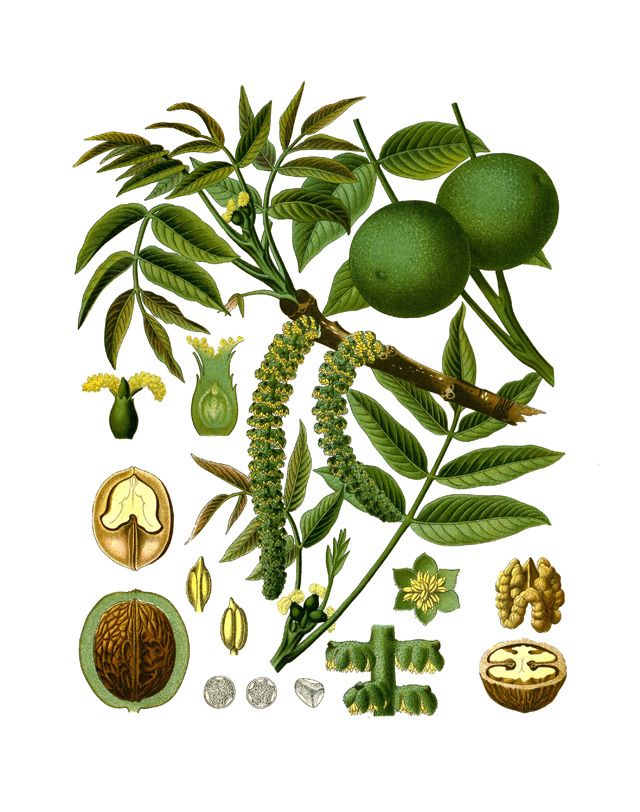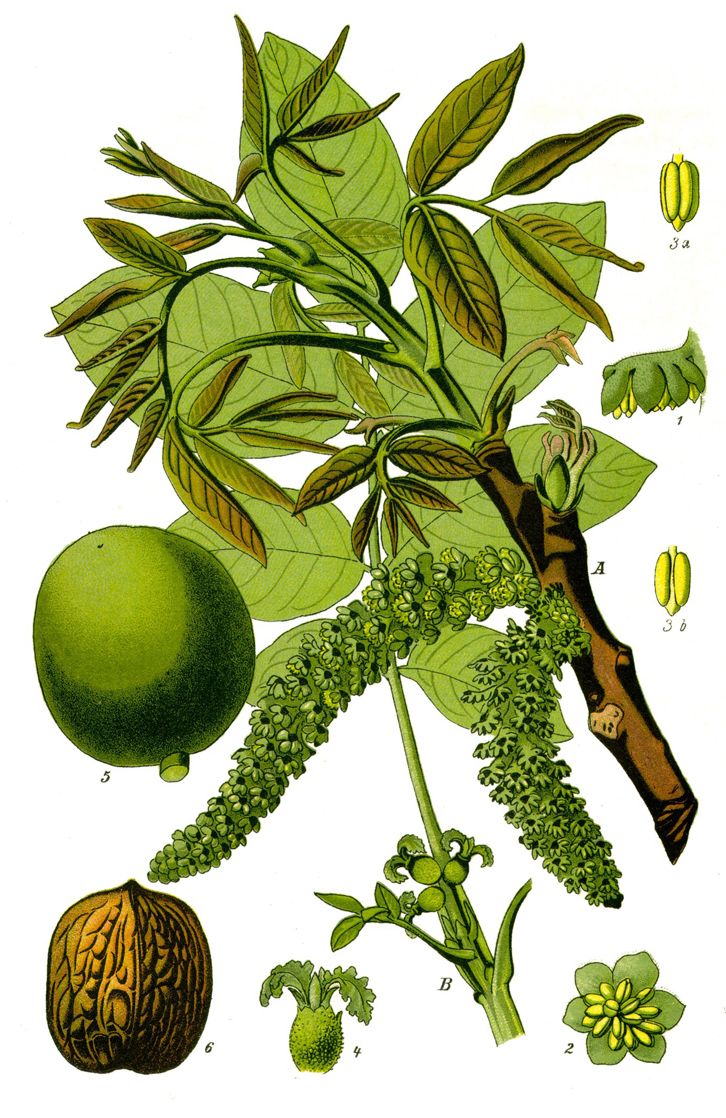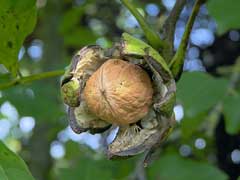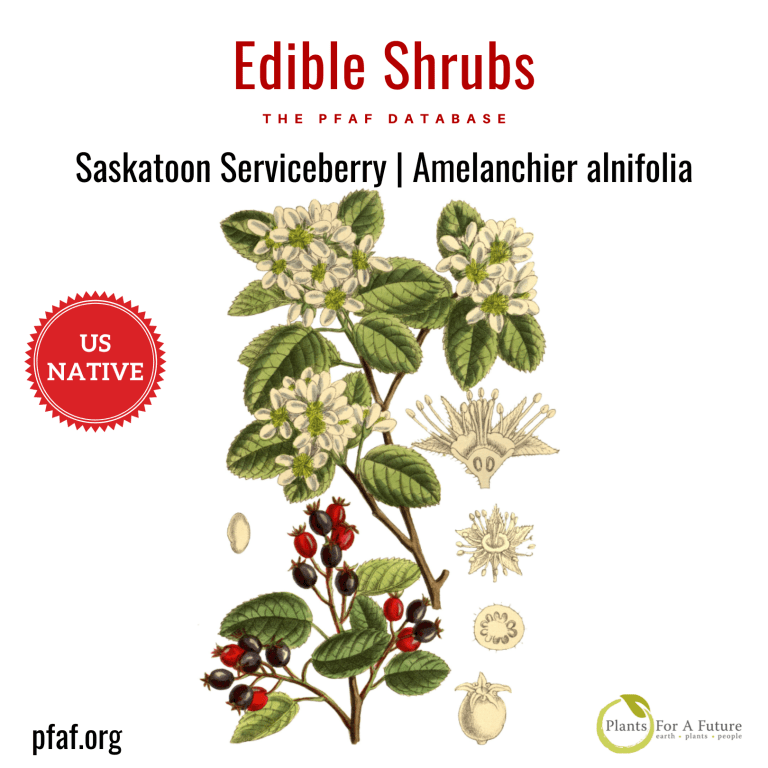English Walnut is a medium to large deciduous tree growing to 20m (65ft) by 20m (65ft) at a medium rate and with a trunk up to 2m diameter. It has a long life span. The largest forests are in Kyrgyzstan, where trees occur in extensive, nearly pure walnut forests at 1,000–2,000m altitude. Regia means kingly, in reference to the superior quality of the nuts, and many cultivars of this species are available for commercial production. Leaves are alternately arranged, 25–40cm (10–16”) long, odd-pinnate with 5–9 leaflets, paired alternately with one terminal leaflet. Male flowers are in drooping catkins 5–10cm (2–4”) long, and the female flowers are terminal, in clusters of two to five. It is in flower in high summer, and the seeds ripen in late autumn. The flowers are monoecious and are pollinated by wind. The plant is self-fertile. It is not frost tender. A good planting habitat for English walnut is part of the woodland garden canopy. They are not recommended to be planted by roads. Average nut and oil yields: 4-5kg (8–10lb) at 10 years; 6bu:210L for older trees.
The oil, sap and seed/nut are all edible. The seed is eaten raw or used in confections, cakes, and ice cream and has a delicious flavour. The seed can also be ground into a meal and used as a flavouring in sweet and savoury dishes. The unripe fruits can be pickled in vinegar. Edible oil is obtained from the seed, it should not be stored for any length of time since it tends to go rancid quickly. The oil has a pleasant flavour and is used in salads or for cooking. The sap is tapped in spring and used to make a sugar. The finely ground shells are used in the stuffing of ‘agnolotti’ pasta. They have also been used as adulterant of spices. The dried green husks contain 2.5 – 5% ascorbic acid (vitamin C) – this can be extracted and used as a vitamin supplement. The leaves are used as a tea.
There is scientific evidence that Juglans regia can lower the risk of coronary heart disease and help lower cholesterol. More studies are required to rate the effectiveness for Acne, anemia, diarrhoea, diabetes, eczema, perspiration, skin inflammation, ulcers and a number of other conditions. The walnut tree has a long history of medicinal use, being used in folk medicine to treat a wide range of complaints. The leaves are alterative, anthelmintic, anti-inflammatory, astringent and depurative. They are used internally in the treatment of constipation, chronic coughs, asthma, diarrhoea, and dyspepsia. The leaves are also used to treat skin ailments and purify the blood. They are considered to be specific in the treatment of strumous sores. Male inflorescences are made into a broth and used in the treatment of coughs and vertigo. The rind is anodyne, relieving pain and astringent. It is used in the treatment of diarrhoea and anaemia. The seeds are antilithic, diuretic and stimulant. They are used internally in the treatment of low back pain, frequent urination, weakness of both legs, chronic cough, asthma, constipation due to dryness or anaemia and stones in the urinary tract. Externally, they are made into a paste and applied as a poultice to areas of dermatitis and eczema. The oil from the seed is anthelmintic, helping to expel parasites from the gut. It is also used in the treatment of menstrual problems and dry skin conditions. The cotyledons are used in the treatment of cancer. Walnut has a long history of folk use in the treatment of cancer; some extracts from the plant have shown anticancer activity. The bark and root bark are anthelmintic, astringent and detergent. The plant is used in Bach flower remedies – the keywords for prescribing it are ‘Oversensitive to ideas and influences’ and ‘The link-breaker’.
English walnut has a number of other uses including: dyes, herbicides, oil, paint, polish, a repellent, tannin, and wood. A yellow dye is obtained from the green husks. The rind of unripe fruits is a good source of tannin. A brown dye is obtained from the leaves and mature husks. It does not require a mordant and turns black if prepared in an iron pot. The dye is often used as a colouring and tonic for dark hair. The leaves and the husks can be dried for later use. A golden-brown dye is obtained from the catkins in early summer. It does not require a mordant. A drying oil is obtained from the seed and used in soap making, paints, etc, but it is not very stable and quickly goes rancid. The nuts can be used as a wood polish – simply crack open the shell and rub the kernel into the wood to release the oils, then wipe off with a clean cloth. The dried fruit rind is used to paint doors and window frames (it probably protects the wood due to its tannin content). The shells may be used as anti-skid agents for tyres, blasting grit, and in the preparation of activated carbon. The leaves contain juglone, this has been shown to have pesticidal and herbicidal properties. The crushed leaves are an insect repellent. Juglone is also secreted from the roots of the tree, it has an inhibitory effect on the growth of many other plants. Bark of the tree and the fruit rind are dried and used as a tooth cleaner. They can also be used fresh. Walnut wood is heavy, hard, durable, close grained, and seasons and polishes well. A very valuable timber tree, it is used for furniture making, veneer etc.
English walnut requires a deep well-drained loam and a sunny position sheltered from strong winds. It prefers a slightly alkaline heavy loam but will succeed in most soils. There’s an old adage that walnuts will grow where apples grow. The walnut tree is reported to tolerate an annual precipitation of 31 to 147cm (12ins to 58ins), an annual temperature in the range of 7.0 to 21.1°C (44 to 70°F) and a pH in the range of 4.5 to 8.2. The dormant plant is very cold tolerant, tolerating temperatures down to about -27°C (-17°F) without serious damage, but the young spring growth is rather tender and can be damaged by late frosts. Some late-leafing cultivars have been developed, these often avoid damage from spring frosts and can produce a better quality timber tree. The walnut tree is frequently cultivated for its edible seed in temperate zones of the world, there are many named varieties. Newer cultivars begin producing nuts in 5–6 years; by 7–8 years, they produce about 2.5 tons of nuts per hectare. Orchards on relatively poor, unirrigated mountain soil report 1.5 – 2.25 tonnes per hectare, orchards in well cultivated valleys, 6.5–7.5 tonnes per hectare. According to the Wealth of India, a fully grown individual can yield about 185 kg, but 37 kg is more likely. Trees grow well in most temperate areas but they often fail to fully ripen their fruits or their wood in cooler and damper climates, they prefer a more continental climate. Walnuts can produce large healthy trees in many parts of Britain, but seedling trees often do not fruit reliably. Some European varieties have been developed that succeed in colder areas. Seedling trees are said to take from 6 to 15 years to come into fruit from seed, but these cultivars usually start cropping within 5 years. Plants produce a deep taproot and they are intolerant of root disturbance. Seedlings should be planted out into their permanent positions as soon as possible and given some protection for their first winter or two since they are somewhat tender when young. Flower initiation depends upon suitable conditions in the previous summer. The flowers and young growths can be destroyed by even short periods down to -2°c (28°F), but fortunately plants are usually late coming into leaf. Some cultivars are self-fertile, though it is generally best to grow at least two different cultivars to assist in cross-pollination for heavier crops. Any pruning should only be carried out in late summer to early autumn or when the plant is fully dormant, otherwise wounds will bleed profusely and this will severely weaken the tree. Plants produce chemicals which can inhibit the growth of other plants. These chemicals are dissolved out of the leaves when it rains and are washed down to the ground below, reducing the growth of plants under the tree. The roots also produce substances that are toxic to many plant species, especially apples (Malus species), members of the Ericaceae, Potentilla spp and the white pines (certain Pinus spp.). Trees have a dense canopy which tends to reduce plant growth below them. All in all, not the best of companion trees, it is also suggested that the trees do not like growing together in clumps. Walnuts are also said to inhibit the growth of potatoes and tomatoes. Hybridizes with J. nigra. This species is notably susceptible to honey fungus. The bruised leaves have a pleasant sweet though resinous smell.
The seed is best sown as soon as it is ripe in individual deep pots in a cold frame. You need to protect it from mice, birds, squirrels etc. The seed usually germinates in late winter or the spring. Plant out the seedlings into their permanent positions in early summer and give some protection from the cold for their first winter or two. The seed can also be stored in cool moist conditions (such as the salad compartment of a fridge) over the winter and sown in early spring, but it may then require a period of cold stratification before it will germinate. Named varieties are propagated by budding.
English Walnut Juglans regia
Family: Juglandaceae
Known Hazards: None known
Natural Habitats: Forests in the Himalayas, preferring a northerly aspect in the west but a southerly or westerly aspect in the east of the range.
Natural Range: E. Europe to N. Asia. More or less naturalized in S. Britain.
Hardiness Zones: USDA 7–9. PFAF 5. Not frost tender.
Type & Size: Large deciduous tree 20m (65ft) high by 20m (65ft) wide.
Growth: Medium
Soil: light (sandy), medium (loamy) and heavy (clay) soil. It prefers well-drained soil moist soil.
Soil pH: acid, neutral and basic (alkaline) soils.
Light: It cannot grow in the shade.
References: 1, 2, 4, 5, 6, 7, 9, 11, 12, 18, 20, 21, 34, 37, 46, 48, 57, 61, 63, 78, 80, 100, 113, 117, 132, 144, 145, 147, 148, 149, 158, 159, 168, 169, 176, 183, 200, 201, 209, 218, 238, 240, 245, 269, 305, K
Edible Rating 4
Medicinal Rating 3




Database Page: http://www.pfaf.org/user/Plant.aspx?LatinName=juglans+regia







